![]()
![]()
![]()
![]()
![]()
![]()

![]()
Sign the Guestbook
View the Guestbook

Atari Products | A Bit of History | Memo Pad | 1st Word | Links | Home
[the following article is from the August 1985 issue of COMPUTE! Magazine]
Report From The Summer
Consumer Electronics Show
|
Tom R. Halfhill, Editor
Considerably less frantic than past Consumer Electronic Shows-at least in the computer section-this summer's CES nevertheless showcased some ground breaking new products. Foremost was Atari's announcement of a mass storage device that may bring optical memory into homes, schools, and businesses by early 1986.
Still, something was noticeably different about this June's CES in Chicago. The annual noise which emanates from the personal computer section in the McCormick West building had dissipated to a muffled roar. Only two U.S. computer manufacturers were in attendance: Commodore and Atari. IBM and Apple, as is their custom, skipped the show. Atari, which a few weeks earlier had announced it was pulling out of CES, was enticed back by the show management but occupied a couple of meeting rooms instead of its extravagant exhibit of days past. And the lower level of McCormick West, once the exclusive domain of a hundred computer software companies, now was half filled with videotape exhibits and purveyors of video porn. Rarely have the effects of the much publicized industry shakeout been so apparent. On the bright side, the mood was just slightly more optimistic as both Atari and Commodore moved closer to shipping actual production models of their latest personal computers. In fact, as the show opened, Atari said it had delivered the first 5,000 of its new 520STs to Canada and Europe and was expecting large-volume shipments to the U.S. by July 8. Commodore said it was only weeks away from shipping the Commodore 128, and was gearing up for a press conference in late July to officially announce its eagerly anticipated Amiga computer. Several software companies announced new products for the Commodore 128, Amiga, and Atari ST series, although most seem to be cautiously hanging back until they see how the machines fare. On the hardware front, Atari announced a mass-market version of the ST, Commodore exhibited a dual disk drive for the Commodore 128, and a British company announced it would export a 128K computer to the U.S. But the most interesting news from the show was a revolutionary new peripheral displayed for the first time by Atari: A very fast mass storage device that uses high-density optical discs. It was a dramatic demonstration that the upcoming generation of personal computers will place much of the power of a mainframe computer on a desktop. It also showed that the personal computer industry is not only far from finished, but is just getting started. |
||
| Next Page -> |
see also: Monster Memory
Atari Products | A Bit of History | Memo Pad | 1st Word | Links | Home
